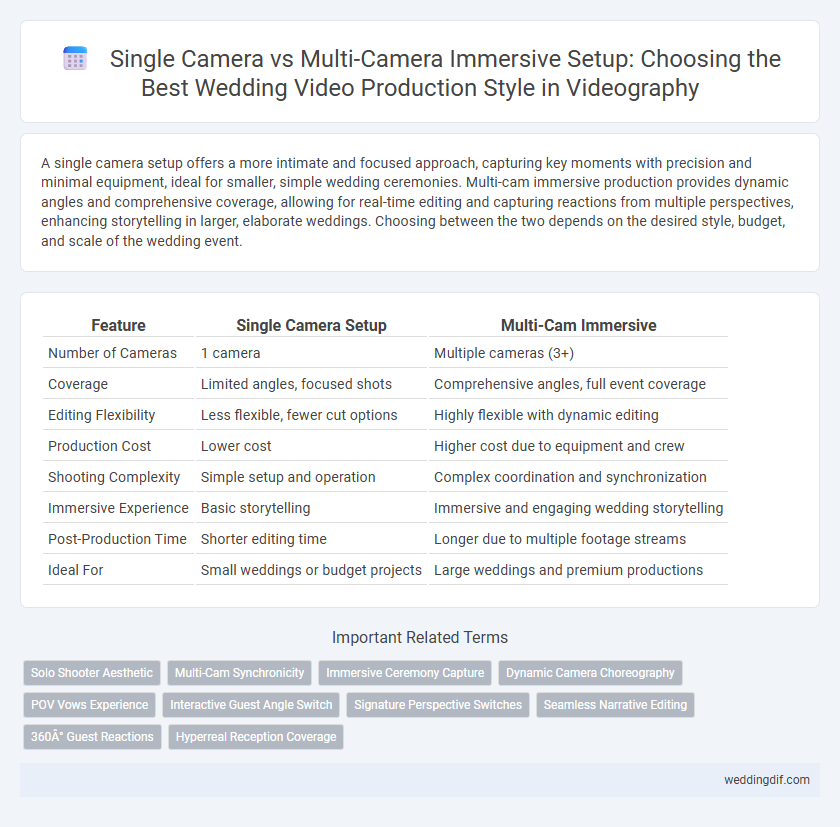A single camera setup offers a more intimate and focused approach, capturing key moments with precision and minimal equipment, ideal for smaller, simple wedding ceremonies. Multi-cam immersive production provides dynamic angles and comprehensive coverage, allowing for real-time editing and capturing reactions from multiple perspectives, enhancing storytelling in larger, elaborate weddings. Choosing between the two depends on the desired style, budget, and scale of the wedding event.
Table of Comparison
| Feature | Single Camera Setup | Multi-Cam Immersive |
|---|---|---|
| Number of Cameras | 1 camera | Multiple cameras (3+) |
| Coverage | Limited angles, focused shots | Comprehensive angles, full event coverage |
| Editing Flexibility | Less flexible, fewer cut options | Highly flexible with dynamic editing |
| Production Cost | Lower cost | Higher cost due to equipment and crew |
| Shooting Complexity | Simple setup and operation | Complex coordination and synchronization |
| Immersive Experience | Basic storytelling | Immersive and engaging wedding storytelling |
| Post-Production Time | Shorter editing time | Longer due to multiple footage streams |
| Ideal For | Small weddings or budget projects | Large weddings and premium productions |
Introduction: Choosing the Right Wedding Video Setup
Selecting the ideal wedding video setup significantly impacts the storytelling and final output quality. A single camera setup offers simplicity and intimacy, capturing key moments with focused attention, while a multi-cam immersive approach provides dynamic angles and comprehensive coverage of the event. Understanding the couple's vision and event scale guides the choice between streamlined elegance and rich, cinematic narratives in wedding videography.
Understanding Single Camera Wedding Videography
Single camera wedding videography captures events from one consistent perspective, emphasizing cinematic storytelling with controlled framing and lighting. This setup allows for greater creative focus on composition and emotional moments, but may require more precise planning to ensure key scenes are recorded. Understanding the limitations and strengths of single camera setups helps videographers deliver intimate, polished wedding films.
Exploring Multi-Cam Immersive Wedding Production
Multi-cam immersive wedding production enhances storytelling by capturing diverse angles and spontaneous moments, creating a dynamic and engaging viewing experience. Utilizing multiple cameras allows for simultaneous coverage of key events like vows, reactions, and celebrations, ensuring no critical moments are missed. This setup optimizes post-production flexibility, enabling seamless transitions and a polished narrative that single-camera setups often cannot achieve.
Key Differences: Single Camera vs Multi-Cam Approaches
Single camera setups in wedding video production offer a controlled perspective, emphasizing cinematic storytelling through carefully planned shots and angles. Multi-cam immersive techniques capture multiple angles simultaneously, providing dynamic coverage and real-time edits for a comprehensive and engaging viewer experience. Choosing between single camera and multi-cam depends on the desired narrative style, event scale, and post-production flexibility.
Capturing Emotions: Depth and Perspective in Each Setup
A single camera setup in wedding videography offers intimate, focused shots that capture raw emotions and personal moments with depth and clarity. Multi-cam immersive setups provide diverse perspectives and dynamic angles, enabling a comprehensive narrative by capturing reactions, ceremonies, and crowd interactions simultaneously. Combining both methods enhances storytelling by balancing emotional depth with expansive coverage, creating a richer, more engaging wedding video.
Cost and Budget Considerations for Couples
A single camera setup for wedding video production offers a cost-effective solution, minimizing equipment rental and crew expenses, making it ideal for couples on a tight budget. Multi-cam immersive productions involve higher costs due to multiple camera operators, enhanced editing requirements, and increased post-production time, which can significantly impact the overall budget. Couples should weigh the value of cinematic variety and coverage against these financial considerations to determine the best fit for their wedding videography needs.
Editing Complexity and Post-Production Workflow
Single camera setups simplify editing by providing a linear sequence of footage, reducing the need for synchronization but limiting coverage angles. Multi-cam immersive setups increase editing complexity with multiple synchronized video streams, requiring advanced software and skilled editors to seamlessly switch between angles for dynamic storytelling. Efficient post-production workflows for multi-cam projects involve organized file management, timecode syncing, and color matching to ensure consistent visual quality across all camera feeds.
Flexibility and Coverage: What Each Setup Offers
A single camera setup in wedding videography provides greater flexibility for intimate shots and dynamic movement, allowing the videographer to focus on capturing detailed moments with creative angles. Multi-cam immersive setups offer extensive coverage by simultaneously recording multiple perspectives, ensuring comprehensive documentation of key events such as vows, reactions, and the reception. Combining both approaches can optimize storytelling by balancing fluid cinematography with expansive visual storytelling.
Impact on the Wedding Experience and Guest Interaction
A single camera setup offers a more intimate and unobtrusive approach, allowing the videographer to capture candid moments without disrupting guest interactions, preserving the natural flow of the wedding experience. Multi-cam immersive setups provide comprehensive coverage from multiple angles, enhancing storytelling by capturing simultaneous reactions and dynamic perspectives but may intrude on the ambiance with increased equipment presence. Balancing these setups impacts how guests engage with the event and how authentically the emotional atmosphere is documented.
Making the Best Choice: Factors for Couples to Consider
Couples should evaluate their wedding venue, budget, and desired video style when choosing between single camera setup and multi-cam immersive videography. Single camera setups offer a more intimate, cinematic approach ideal for smaller venues, while multi-cam immersive captures multiple angles simultaneously, creating dynamic storytelling and comprehensive coverage. Prioritizing desired video complexity, editing preferences, and the videographer's expertise ensures the best choice aligns with the couple's vision and wedding logistics.
Single Camera Setup vs Multi-Cam Immersive for wedding video production. Infographic

 weddingdif.com
weddingdif.com